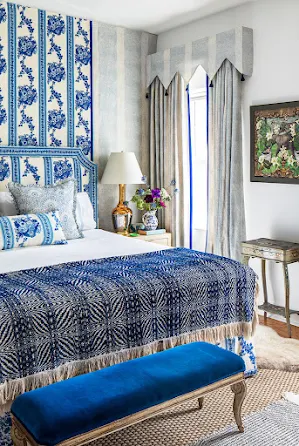How to Mix Patterns in Your Bedroom Like a Pro
Your bedroom should reflect your personality, and one of the most stylish ways to achieve that is by mixing patterns. Layering patterns can bring depth, interest, and a designer touch to your space when done correctly. However, if done haphazardly, it can quickly turn chaotic. Using a well-structured approach, the key to success lies in balancing boldness with subtlety. Here’s how to mix patterns in your bedroom while maintaining harmony and elegance.
1. Start with an Anchor Pattern
The anchor pattern is the star of your room’s design. It should be bold and engaging and set the overall theme for your space. Think of a large floral, an eye-catching geometric, or an artistic abstract design that catches attention without overwhelming the room. This pattern will serve as your guide for selecting complementary patterns and colors.
Where to Use the Anchor Pattern:
Upholstered headboard
Large area rug
Wallpaper on an accent wall
Statement bedding, such as a duvet cover or comforter
For example, if you choose a bold botanical wallpaper with deep green leaves and soft pink flowers, you’ll want to build the rest of the room’s patterns around those colors and motifs.
2. Balance with Solids
Once you have your anchor pattern, introduce solid colors to prevent the space from feeling too busy. Solids serve as a visual break and allow the eye to rest while enhancing the boldness of your main pattern.
Where to Use Solids:
Bed linens (sheets, pillowcases, or blankets)
Upholstered furniture, like a chair or bench
Walls, if you’re not using wallpaper
Curtains, if you want a calming effect
Choose solids that complement the colors in your anchor pattern. If your anchor piece has navy and white, consider solid gray or a muted shade of blue for balance.
3. Introduce Two Smaller Patterns
Layer in two additional patterns with minor, subtler designs to create depth and sophistication. These secondary patterns should contrast with your anchor but maintain a cohesive look.
Types of Supporting Patterns:
Stripes: Classic and versatile stripes work well with nearly any pattern.
Polka Dots: Playful and light, polka dots add a touch of whimsy.
Herringbone or Chevron: These geometric designs add structure and modernity.
Toile or Small Florals: Perfect for a softer, vintage-inspired space.
How to Mix These Patterns:
If your anchor pattern is a large floral, complement it with thin, subtle stripes and small polka dots.
If your anchor is a bold geometric print, balance it with delicate florals and textured solids.
Where to Use Secondary Patterns:
Throw pillows
A secondary rug (layering rugs adds extra warmth!)
Lampshades
Accent chairs or ottomans
4. Add Texture for Dimension
Mixing patterns isn’t just about visuals; incorporating different textures enhances depth and coziness. The texture is crucial in making a pattern-heavy room feel balanced and inviting.
Ways to Add Texture:
Velvet or Chenille: Use for throw pillows, upholstery, or drapes to create a rich and luxurious feel.
Linen or Cotton: Opt for natural fibers for a breathable, relaxed look.
Woven Materials: Jute rugs, rattan furniture, or knitted blankets introduce organic warmth.
Quilted or Embroidered Details: These intricate designs help create a handcrafted appeal.
If your patterns consist primarily of smooth, printed fabrics, incorporate rougher textures like a chunky knit throw or a woven headboard to create contrast.
5. Stick to a Cohesive Color Palette
A well-coordinated color scheme ties together multiple patterns without feeling overwhelming. Stick to a three-color rule: one dominant color (which appears in the anchor pattern), one secondary color, and one accent color.
For example:
Dominant Color: Deep navy (from a patterned wallpaper)
Secondary Color: Soft blush (from a solid duvet cover)
Accent Color: Warm gold (in striped pillows and metallic decor)
Keeping colors harmonious ensures that even bold patterns feel unified rather than chaotic.
Conclusion: Making Patterns Work for You
Mixing patterns in your bedroom doesn’t have to be intimidating. By starting with a bold anchor pattern, balancing it with solids, introducing two smaller complementary patterns, adding texture, and sticking to a cohesive color scheme, you can create a space that feels stylish, cozy, and uniquely yours.
Remember, the key is balance. Patterns should enhance the overall ambiance rather than compete for attention. Experiment with swatches and textiles before committing to a final design. With the right mix, your bedroom can become a beautifully curated retreat that feels lively and restful.
So go ahead, have fun with patterns, and transform your bedroom into a space that truly reflects your personality!







Comments
Post a Comment